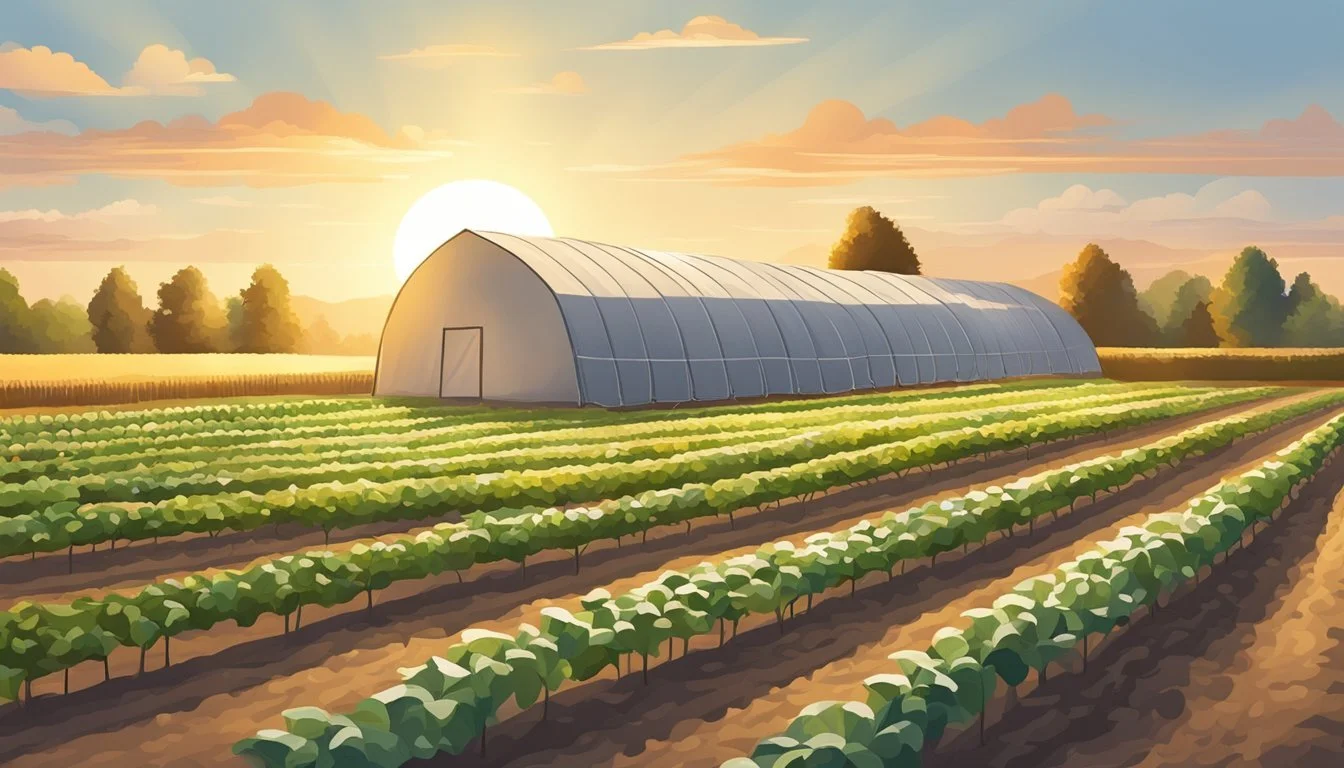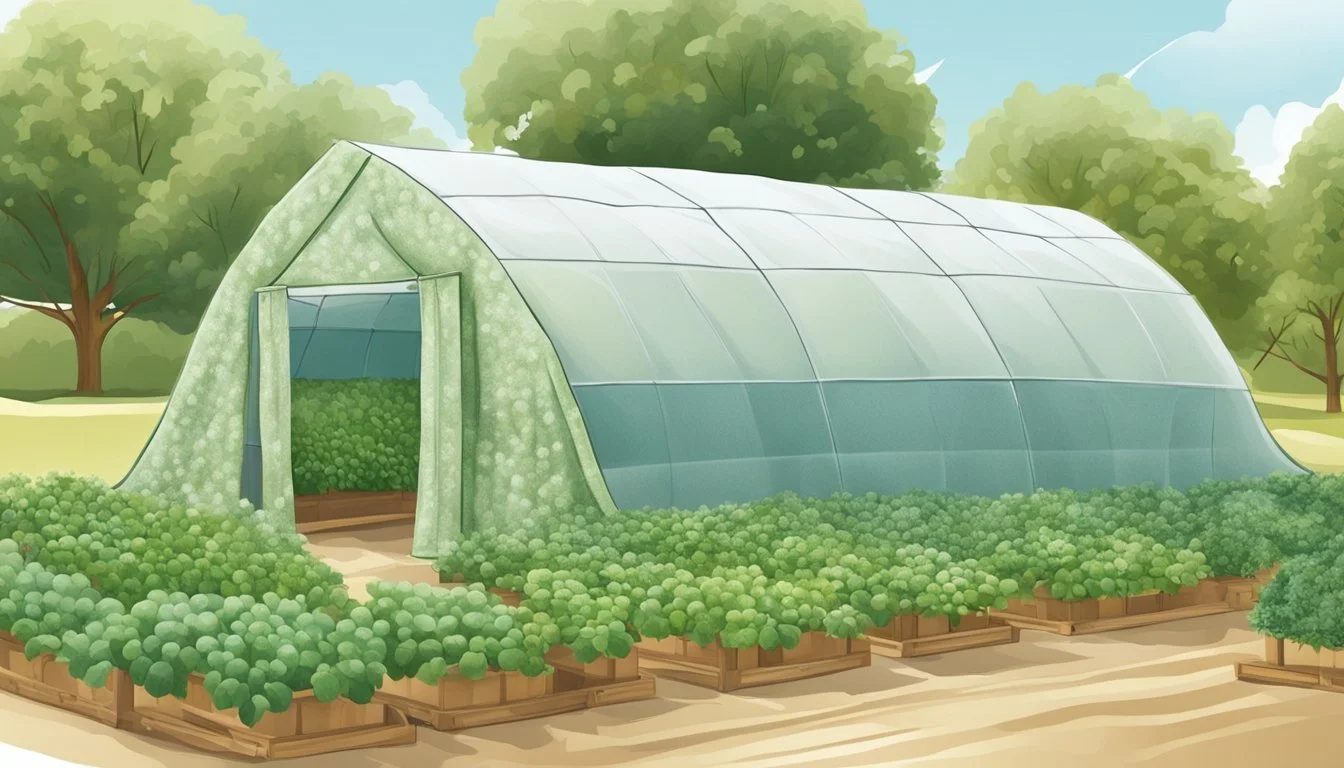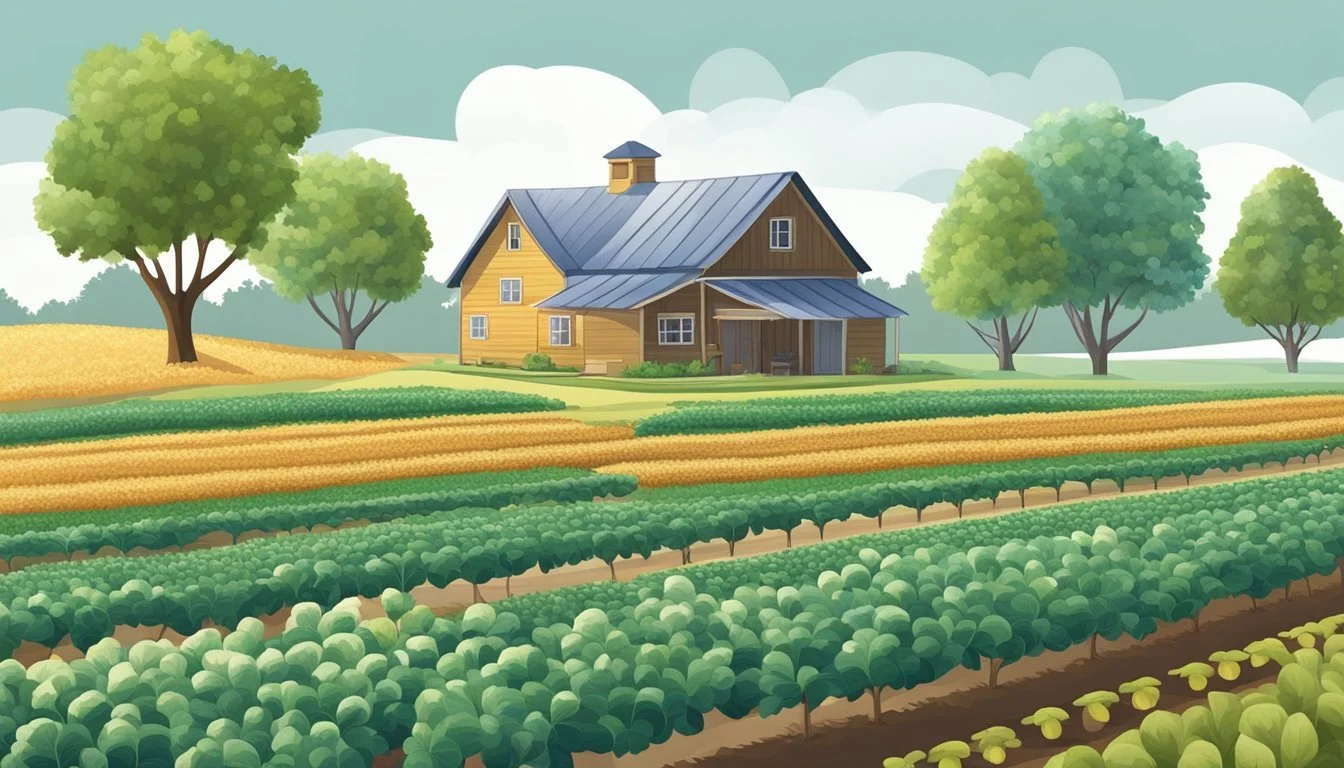The Ultimate Guide to Using Crop Cover Fabric
Shielding Your Homestead from Frost and Pests
Crop cover fabric is an essential tool for homesteaders striving to extend the growing season and safeguard their gardens from the elements. This versatile material, also known as row cover, offers a defense mechanism against frost, providing an additional layer of insulation that can retain warmth on colder nights. In areas susceptible to frost, even a light fabric has the capability to add a few critical degrees of warmth, enabling crops to thrive in temperatures that would have otherwise caused damage.
In addition to frost protection, crop cover fabric serves as a barrier against a variety of pests. For gardeners troubled by insects such as cabbage moths, aphids, and beetles, the use of a lightweight row cover can prevent these pests from reaching the plants altogether. It's a non-chemical approach to pest control, which aligns well with organic gardening practices. The fabric is permeable, allowing sunlight and water to nourish the plants, while simultaneously keeping unwanted visitors at bay.
Employing crop cover fabric correctly is vital for maximizing its benefits. Securing the edges with stakes or weights ensures the cover doesn't get lifted by the wind and that it stays in position to protect the garden. Homesteaders must select the appropriate weight of fabric for their specific climate conditions—lighter fabrics for mild areas and heavier ones for locations with harsher weather. By choosing the correct fabric and using it effectively, growers can enhance plant growth and yield, despite challenges posed by nature.
Understanding Frost and Its Effects on Plants
Frost poses critical challenges to plants, which can range from minor damage to their foliage to significant impacts on their survival and yield, especially in vegetables like tomatoes, lettuce, spinach, kale, and beets.
Types of Frost and Risk Assessment
Frost events can be mainly categorized into two types: radiation frost and advective frost.
Radiation frost occurs on clear, calm nights when heat escapes from the earth's surface.
Advective frost involves a mass of cold air settling over an area, often accompanied by wind.
Risk assessment for frost requires recognizing parameters such as the local climate, topography, and the specific microclimate where the plants are grown. When assessing risk, one must consider:
Clear Skies: Increases risk of radiation frost as there is no cloud cover to retain heat.
Calm Winds: Leads to a stable layer of cold air close to the ground, heightening the chance of frost.
Humidity: Low humidity can lead to sharper temperature declines.
Plant Location: Low-lying areas tend to collect cold air and are therefore more susceptible to frost.
Plants vary in their resilience to frost; for example, beets can withstand cooler temperatures, while tomatoes are more susceptible.
Frost Damage and Plant Vulnerability
Frost damage on plants manifests in several ways, impacting cellular structures and physiological processes. Ice crystals that form inside plant tissue can lead to cell walls bursting, which is often visibly noted as browning or wilting of the foliage. Vulnerability significantly differs among plant species and their growth stages. For instance:
Tomatoes are highly susceptible to frost, with temperatures just below freezing causing damage to leaves and fruit.
Leafy vegetables such as lettuce, spinach, and kale can tolerate light frosts, but prolonged exposure can be detrimental.
Beets are more hardy, withstanding frost better due to their root structure and sugar content, which lowers the freezing point of cell sap.
Understanding the level of frost tolerance for each plant is crucial for implementing appropriate protective measures when temperatures drop.
Benefits of Crop Cover Fabric in Cold Weather
Crop cover fabric serves as a critical tool for gardeners and farmers, providing essential frost protection and aiding in the extension of the growing season.
Insulation and Heat Retention
Crop cover fabric, often known as frost cloth or frost blanket, is a textile specifically designed to act as an insulating barrier between tender plants and the harsh cold. When temperatures drop, the fabric traps heat from the soil and plant respiration, preventing the cold air from damaging sensitive plant tissues. Insulation provided by these covers retains this warmth, which is particularly beneficial during unexpected cold snaps or frosty nights. By maintaining a more consistent microclimate, the risk of frost damage is significantly reduced.
Extending the Growing Season
Using crop cover fabric, or row covers, during the winter months doesn't just offer frost protection; it's also a powerful season extension technique. These covers can boost the air temperature around plants by several degrees, creating an environment conducive to continued growth. With this added warmth, gardeners can sow certain crops earlier in the spring and keep them growing later into the fall. This effectively lengthens the available growing season, ensuring that one can harvest fresh produce for a longer period throughout the year.
Comparing Different Types of Crop Covers
Understanding the distinctions between crop covers is crucial for homesteaders to make informed decisions and protect their plants effectively. The properties of the cover, such as weight, material, and breathability, directly influence the degree of protection against frost and pests.
Floating Row Covers vs. Frost Blankets
Floating Row Covers:
Material: Typically made of lightweight, breathable polypropylene.
Usage: They allow light and water to reach the plants while providing a barrier against insects.
Weight: Usually lightweight, which prevents damage to the plants they cover.
Frost Blankets:
Material: Can be made of a heavier weight fabric for added warmth.
Usage: Principally utilized to shield plants from frost damage by retaining heat.
Weight: Versions include medium to heavy weight for different levels of insulation.
Selecting the Right Material
Lightweight Fabric:
Designed for minimal frost protection and allowing maximum light penetration.
Suitable for insect barrier without the risk of overheating.
Medium Weight Fabric:
Offers a balance of light transmission and frost protection.
Typically used for extended periods in the growing season.
Heavy Weight Fabric:
Provides the best insulation for plants against cold.
Reduces light transmission, so typically used for short periods during peak frost conditions.
Protecting Plants from Pests with Crop Covers
Crop covers offer a significant advantage in an integrated pest management strategy, providing a physical barrier between plants and common garden pests. By using crop covers, gardeners can effectively reduce damage from insects and larger pests.
Creating Barriers Against Common Pests
Crop covers, such as insect netting, are designed to keep pests ranging from tiny aphids to larger creatures like deer and rabbits away from plants. Here is how they can be utilized:
Insect Netting: This fine mesh material can prevent cabbage moths, cucumber beetles, leaf miners, and cabbage loopers from reaching susceptible plants. Gardeners should ensure that the netting is secured to the ground to prevent pests from entering.
Deer and Rabbit Prevention: Larger pests can be deterred using more robust netting options. The key is to erect the netting in a way that it remains taut and at a sufficient height to dissuade deer from jumping over.
Integrating Pest Management Strategies
Incorporating crop covers into a larger pest management plan enhances their effectiveness:
Monitoring: Regularly check under the covers for any signs of pest presence or damage.
Weed Control: Keeping the area free from weeds reduces overall pest pressure as weeds can often host pests.
Timely Application: Install crop covers before pest populations peak, usually right after planting.
By focusing on specifics such as selecting the right type of netting for the crop and combining physical barriers with vigilant monitoring, crop covers can provide a solid line of defense against a variety of pests.
Ensuring Successful Pollination and Plant Growth
Using crop cover fabric effectively means balancing the benefits of frost and pest protection with the needs of the plants for successful pollination and healthy growth. The use of the fabric should be strategic to allow for these essential processes.
Balance Between Protection and Pollination
Crop cover fabric serves as a barrier against frost and pests, but careful management is necessary to facilitate pollination. Option A is to use row covers that are light enough to allow pollinators such as bees, butterflies, and other beneficial insects to pass through while still offering protection. Option B involves timing; growers can remove the covers during key pollination periods, especially when flowers are in bloom. It's crucial to monitor flowering schedules and local pollinator activity to determine the best times for removal.
Daily Schedule Example for Balanced Pollination:
Early Morning: Leave the fabric on to protect from cooler temperatures.
Mid-Morning to Afternoon: Remove the fabric to allow sunlight and pollinators to access the plants.
Dusk: Replace the fabric to guard against pests and potential overnight frost.
Maintaining a Healthy Microclimate for Plants
While crop cover fabrics shield plants from external stressors, they also create a unique microclimate underneath. This microclimate must be managed to provide the optimal conditions for plant growth. Key elements include:
Sunlight: The right fabric choice allows sunlight to reach the plants, fostering photosynthesis and warmth.
Airflow: Adequate air circulation is crucial to prevent overheating and to nurture a vibrant ecosystem underneath the fabric.
Humidity: Balancing humidity levels is essential to discourage the growth of mold and mildew while promoting healthy plant development.
To maintain this microclimate, growers might opt for permeable or vented fabric options and regularly lift the covers for ventilation. Periodic monitoring of the microclimate ensures the plants thrive under the fabric’s protection, extending the growing season and ensuring robust plant growth.
Installation and Maintenance of Crop Covers
Proper installation and regular maintenance are crucial for maximizing the effectiveness of crop cover fabrics. These elements ensure the sustainment of optimal conditions for crop growth and protection from frost and pests.
Constructing Support Structures
Support Structures for Raised Beds: One must construct frames or hoops over raised beds that create a suitable form to drape the crop cover. Hoops made of PVC or metal can be inserted into the ground or attached to the beds. DIY enthusiasts often bend metal piping or use flexible PVC to create arches every 2-4 feet across the bed.
Materials Needed:
PVC pipes or metal rods for hoops
Stakes for securing
Tools: pipe cutter or saw, measuring tape
Hoop House Assembly: Larger scale gardens may necessitate a hoop house structure. Galvanized steel or PVC is used for the hoops, and the structure is mounted to a baseboard secured to the ground to withstand wind.
Steps:
Insert hoops at even intervals.
Secure hoops with stakes or ground posts.
Attach a baseboard along the perimeter, if necessary.
Attaching and Securing Covers
Once the structure is in place, one must carefully attach the frost or pest cover fabric. The cover should extend beyond the edges of the garden bed or hoop house to allow for adequate anchoring with weights or sandbags.
Ensure Secure Attachment:
Use clips or ties made for this purpose to attach covers to hoops, preventing wind damage.
Corner areas may require additional rocks or heavy objects to maintain cover.
Anchoring Edges:
Weights or sandbags are typically placed along the edges to keep the fabric secure against wind and pests.
Reinforced edges with grommets can also be useful for tying down covers.
Routine Maintenance and Checks
Daily Checks: One should inspect the crop cover fabric daily for tears, pooling water, or signs of pest intrusion. Regularly checking ensures prompt rectification of any issues, maintaining the protective environment.
Maintenance Tasks:
Clear accumulated debris or snow off the fabric to prevent sagging.
Labor allocated for daily maintenance ensures longevity and efficiency of crop covers.
Seasonal Adjustments: Depending on the season, one might need to adjust the tension of the fabric or replace stakes that have shifted due to soil changes or weather conditions.
By attending to the construction, securement, and maintenance of crop covers with diligence and attention, one can safeguard their crops, minimizing labor and maximizing yield.
Adjusting to Weather Events and Seasons
Effective management of crop cover fabrics involves anticipating and responding to diverse weather events and seasonal changes. Specific adjustments enhance plant protection from frost and pests while balancing light and temperature needs.
Adapting to Changes in Sunlight and Temperature
Farmers should monitor sunlight levels and temperature variations throughout the year. In the fall and winter months, when daylight is reduced, light transmission is crucial for growth. A shade cloth with higher light transmission is ideal, as it allows ample sunlight while offering protection from cooler temperatures. During the rise in temperature, especially in late spring, a cloth with lower light transmission can prevent overheating and provide a stable environment for plant development.
Sunlight in Fall and Winter:
Use cover fabrics with higher light transmission.
Aim to maximize sunlight exposure while providing frost protection.
Temperature in Spring and Late Fall:
Opt for shade cloths with lower light transmission.
Protect plants from heat while still allowing for growth.
Protecting Against Hail, Snow, and High Winds
Hail and snow can cause physical damage to crops, affecting their viability. The use of robust crop cover fabric can shield plants from these harsh elements. The fabric should be firmly anchored to withstand high winds, reducing the risk of tearing and ensuring continuous protection. During snowfall, fabric should be checked regularly and cleared to prevent excessive weight buildup, which could lead to structural damage.
Hail and Snow Protection:
Select durable fabric to safeguard against direct impacts.
Regularly inspect and manage snow accumulation on fabric.
High Wind Prevention:
Securely anchor the fabric to resist wind-related displacement.
Inspect anchor points after events to maintain integrity.
Crop Cover Fabric and Soil Health
Crop cover fabric serves a dual purpose in improving soil health: it conserves soil moisture and temperature while also reducing erosion and managing weed growth. These factors are critical in establishing a hospitable environment for vegetable growth and effective seed germination in garden beds.
Conserving Soil Moisture and Temperature
Soil moisture is essential for plant health, especially during the crucial stages of seed germination and transplanting. Crop cover fabric helps maintain consistent soil moisture levels by reducing water evaporation. This consistent moisture availability can lead to a more uniform and successful germination rate.
Benefits in Temperature Regulation:
Keeps the soil warmer in the early spring
Protects against sudden temperature drops at night
Garden beds covered with fabric can extend the growing season by creating a more stable microclimate. This is particularly beneficial for temperature-sensitive vegetables that require a controlled environment to thrive.
Reducing Erosion and Suppressing Weeds
Crop cover fabrics act as a barrier, protecting soil from the erosive forces of wind and water. By maintaining the soil structure, they ensure that garden beds retain their nutrients and integrity, key aspects for healthy plant development.
Erosion Control: Shields soil from heavy rains and gusts
Weed Suppression: Limits the sunlight reaching the soil, inhibiting weed growth
The prevention of topsoil displacement not only safeguards the ecosystem within the garden beds but also has a pronounced effect on reducing labor from weeding. Furthermore, the minimized presence of weeds reduces competition for nutrients and water, ensuring that the vegetables have access to more resources for their growth.
Integrating Crop Covers into Homestead Design
Integrating crop covers into a homestead’s design requires thoughtful planning tailored to specific needs for frost and pest protection. By considering cover implementation from the outset, gardeners can ensure optimal results and functionality.
Planning Garden Layouts with Covers in Mind
When designing the layout of a garden, one should account for the use of row covers and other types of crop protection. For raised beds, it is beneficial to standardize the bed widths, so that a single size of row cover can be used across the entire homestead. Employing structures like low tunnels can extend the growing season and offer protection from the cold. A simple grid layout, adhering to the following recommendations, enhances the effectiveness of crop covers:
Row Spacing: Allow sufficient space between rows for installation and maintenance of covers.
Bed Orientation: Align garden beds in a north-south direction to maximize sunlight exposure and minimize shadow cast by the covers.
Accessibility: Ensure paths are wide enough for carrying and installing the covers comfortably.
Incorporating Crop Covers in Perennial Gardens
Perennial gardens benefit from the use of bird netting and crop covers to prevent damage from pests and harsh conditions. When integrating covers into perennial setups, one should:
Assess Tree and Shrub Heights: Ensure the cover design accommodates the mature height of trees and shrubs.
Structural Support: For taller plants, robust support structures are essential to uphold the covers without damaging the plants.
Seasonality: Determine the best time to introduce and remove covers to provide adequate protection without hindering the growth of perennial plants.
By planning for crop cover integration into homestead designs, gardeners can effectively safeguard their organic gardens from frost and pests, reinforcing the health and productivity of their garden beds, whether in a greenhouse environment or outdoor raised beds.





